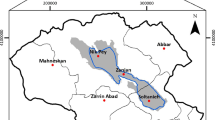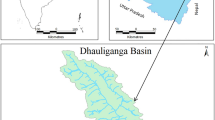Abstract
Kastoria Lake is located in northwestern Greece. The whole basin of the lake is about 253 km2. For the computation of the surface water volume inflowing into the lake from the main streams of the sub-basins located around Kastoria Lake, a rainfall-runoff sub-model is used. A quasi-three-dimensional simulation model of the Kastoria basin aquifer is also realized, in order to estimate the groundwater contribution to the volumetric budget of the lake and the whole basin as well. For the computation of sediment load inflowing into the lake from the main streams of the sub-basins, the rainfall-runoff sub-model is combinedwith a soil erosion sub-model and a sediment transport sub-model for streams. A GIS was developed in the hydrologic basin with all data needed for parameter identification and model application. The data base was enriched by a series of on site measurements of water discharge made in all main streams for one whole hydrologic year. By means of the resulting mathematical sediment model, those sub-basins, which deliver most sediment load to the lake, are identified. On the basis of this identification, a series of control measures, for the reduction of sediment inflowing into the lake, at certain places of the above mentioned sub-basins is proposed.
Similar content being viewed by others
References
Foster, G. R.: 1982, 'Modeling the Erosion Process', in C. T. Haan, H. P. Johnson and D. L. Brakensiek (eds.), Hydrologic Modeling of Small Watersheds, American Society of Agricultural Engineers, Monograph No. 5, pp. 297-380.
Giakoumakis, S. and Tsakiris, G.: 1992, 'Soil Erosion Modeling in the Northern Region of the Mornos River Basin', Proceed. 5th Conference Greek Hydrotechnical Association, Larissa, pp. 111-123 (in Greek).
DVWK (Deutscher Verband für Wasserwirtschaft und Kulturbau): 1988, Feststofftransport in Fließgewässern - Berechnungsverfahren für die Ingenieurpraxis, Schrift 87, Verlag Paul Parey, Hamburg und Berlin.
Hrissanthou, V.: 1989, 'Feststofflieferungsmodell eines Einzugsgebietes', Wasserwirtschaft 79(4), 186-192.
Hrissanthou, V.: 1990, 'Application of a sediment routing model to a Middle European watershed', Water Resour. Bull. 26(5), 801-810.
Hrissanthou, V. and Koudoumakis, P.: 2000, 'Estimation of Sediment Inflow into Kastoria Lake, Determination of Discharge, Sediment andWater Quality in the Torrents of Kastoria Lake Basin', Technical Report, Department of Civil Engineering, Aristotle University of Thessaloniki (in Greek).
McDonald, M. and Harbaugh, A.: 1988, A Modular Three-dimensional Finite-difference Groundwater Flow Model, USGS, Book 6, Chap. A1, 485 p.
Mylopoulos, N.: 1994, 'Stochastic Simulation and Decision Modeling in Groundwater Resources Management under Risk Conditions', Ph.D. Thesis, Department of Civil Engineering, Aristotle University of Thessaloniki, Thessaloniki, Greece (in Greek).
Peck, A., Gorelick, S., de Marsily, G., Foster, S. and Kovalevsky, V.: 1988, 'Consequences of Spatial Variability in Aquifer Properties and Data Limitations for Groundwater Modelling Practice', IAHS Publication No. 175, Wallingford, Oxfordshire.
Poesen, J.: 1985, 'An improved splash transport model', Zeitschrift für Geomorphologie 29(2), 193- 211.
Sakkas, J.: 1994, 'Hydrologic Study of the Basin, Sanitation and Development of Kastoria Lake', Technical Report, Department of Civil Engineering, Democritus University of Thrace (in Greek).
Schmidt, J.: 1992, 'Predicting the Sediment Yield from Agricultural Land using a New Soil Erosion Model', Proceed. 5th International Symposium on River Sedimentation, Karlsruhe, Germany, pp. 1045-1051.
SCS (Soil Conservation Service): 1972, National Engineering Handbook, Section of Hydrology, SCS, Washington D.C., U.S.A.
Thornthwaite, C.W.: 1948, 'An approach toward a rational classification of climate', Geogr. Rev. 38, 55-94.
Tolikas, D.: 2000, 'Existing Sediment Control Measures - Proposals for New Structures, Determination of Discharge, Sediment andWater Quality in the Torrents of Kastoria Lake Basin', Technical Report, Department of Civil Engineering, Aristotle University of Thessaloniki (in Greek).
Vafiadis, P.: 1983, 'Hydrogeological Study of the Kastoria Basin', Ph.D. Thesis, Department of Geology, Aristotle University of Thessaloniki, Thessaloniki, Greece (in Greek).
Wischmeier, W. H. and Smith, D. D.: 1978, 'Predicting Rainfall Erosion Losses. A Guide to Conservation Planning', U.S. Department of Agriculture, Agriculture Handbook No. 537.
Yang, C. T. and Stall, J. B.: 1976, 'Applicability of unit stream power equation', J. Hydraul. Div., ASCE 102(5), 559-568.
Author information
Authors and Affiliations
Corresponding author
Rights and permissions
About this article
Cite this article
Hrissanthou, V., Mylopoulos, N., Tolikas, D. et al. Simulation Modeling of Runoff, Groundwater Flow and Sediment Transport into Kastoria Lake, Greece. Water Resources Management 17, 223–242 (2003). https://doi.org/10.1023/A:1024125920720
Issue Date:
DOI: https://doi.org/10.1023/A:1024125920720




